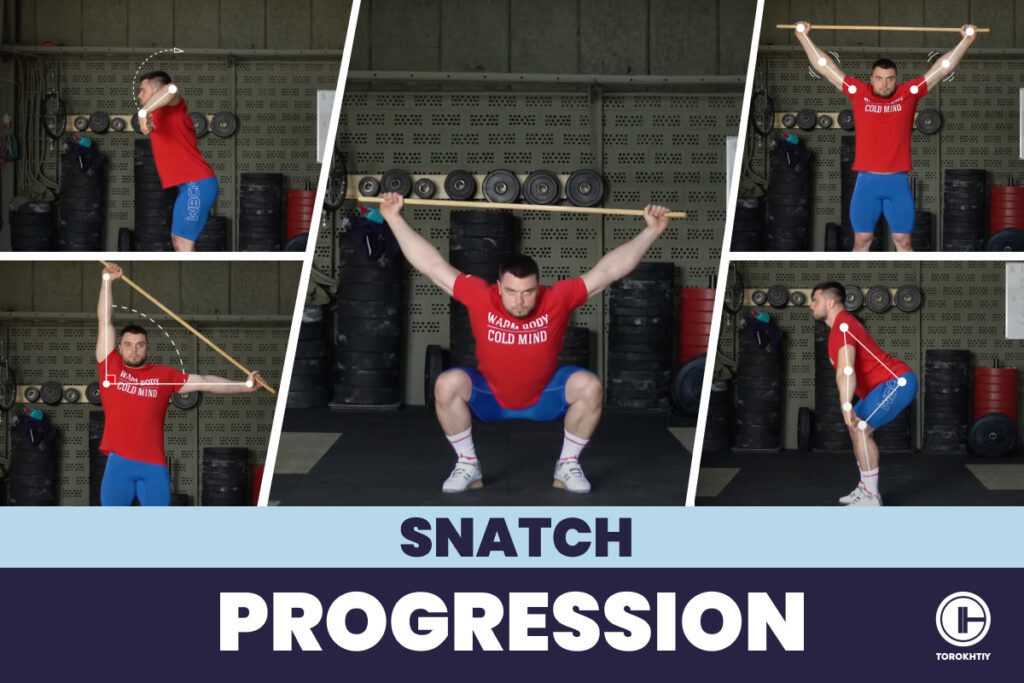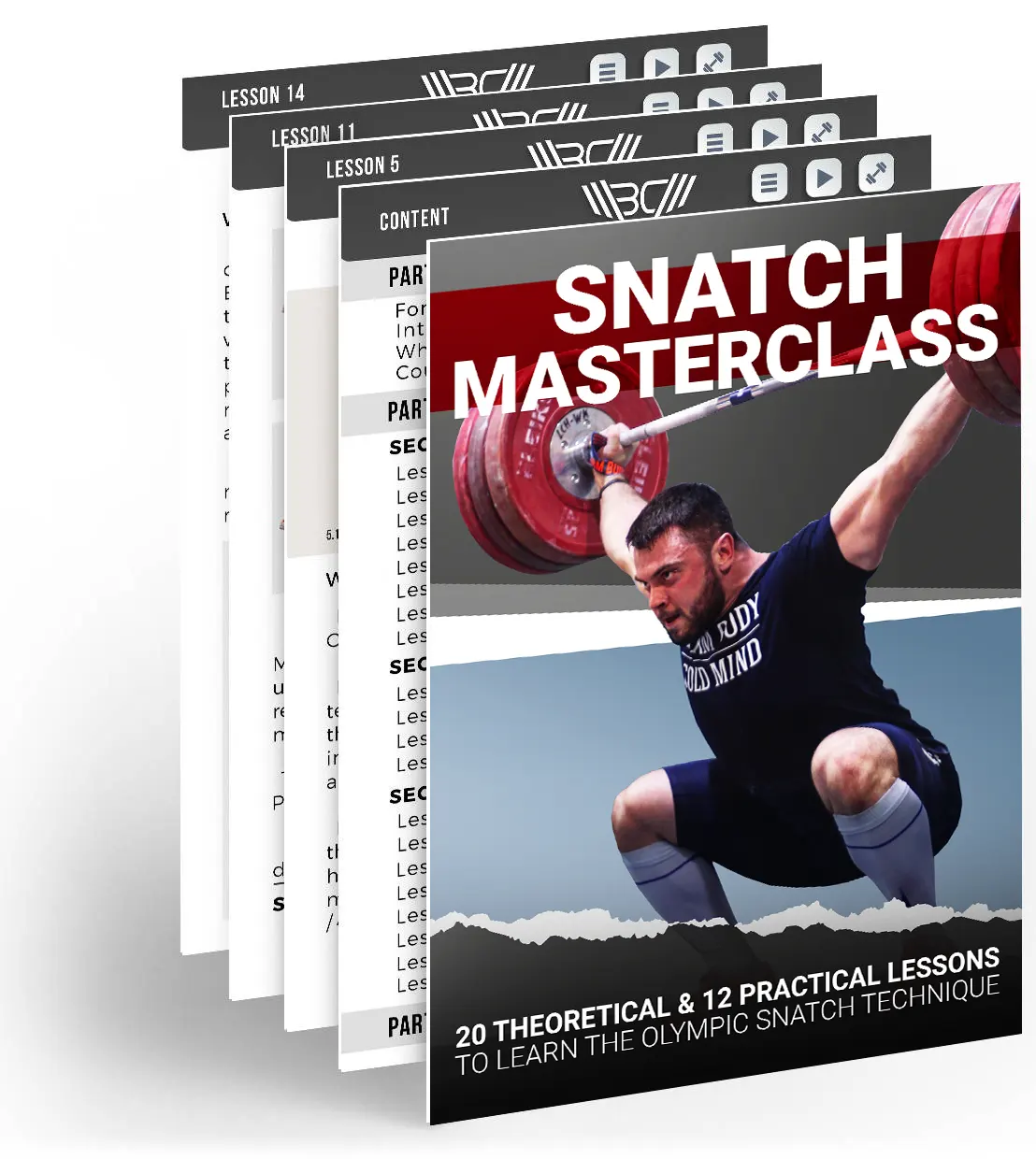Basic Snatch Progression: Technique, Benefits & Common Mistakes
Author:
Reviewed by:
(21 years of Oly Lifting experience)
Unlock your full potential by engaging with our experts and community! Have questions about your fitness journey or looking for expert advice on weightlifting techniques? Don’t hesitate — leave a comment below and Jacek Szymanowski will provide a personalized answer and insights to help you reach your goals.
Torokhtiy is reader-supported. Some links are affiliate links, and we may earn a commission at no extra cost to you. See our disclosure page for details.
Snatch Progression: Elements
This article is devoted to the basic snatch progression teaching that is always offered to athletes at my seminars.
As everybody knows, there are lots of approaches to teaching and they all differ both in the sequence of the proposed phases and elements and in the explanation logic. Seminars and communication with other coaches and athletes from different countries since 2015 made me come to my own version of presenting information and teaching the snatch.
Snatch progression – My own version of the snatch progression includes 11 stages in the ‘top-bottom’ direction which allows athletes to grasp the mechanics and master the exercise confidently. Weightlifters learn the snatch from the overhead fixation to the starting position with the help of various snatch drills.

In this progression I show the optimal movement trajectory construction with its division into 8 simple and clear elements (step). Each subsequent element is a continuation of the previous one, which helps to learn how to perform a snatch in a pretty clear way.
Element 1. Definition of the Snatch Grip
The hand setting is the most basic element and, in my opinion, the first step that should be learned in the snatch progression. Any flaws at this stage may grow into the wrong starting and power positions and often screw up the fixation.
You may like it:
- Detailed Olympic Weightlifting Program For Beginners
- 12-Week Weightlifting Program For Women (Detailed Example)
- Create Your Olympic Weightlifting Program (Examples Included)
An athlete takes a PVC pipe: one arm is parallel to the floor, another one is held vertically. An angle of 90° should be formed in the shoulder joint. This width will be optimal for the athlete. Proper individual hand position in the snatch is a prerequisite for learning the movement as a whole.
After determining your snatch grip, you can start learning the grip types: the overhand grip and the hook grip. In Olympic weightlifting, athletes usually use the hook grip which is the firmest and most reliable grip type.
Grab the barbell with the regular grip but place your thumb under the fingers. It is usually uncomfortable and painful at first but after some time, you will get used to it and understand all the benefits
NOTE: This element is always executed with a PVC pipe only. Never do it with a barbell.
Element 2. Hip Muscle Snatch
Hold the PVC at the hips and pull it up by directing your elbows upward. Start the turnover as the PVC reaches your chest. Then, finish by squeezing your shoulder blades and pushing the PVC up. Make sure to keep the PVC as close to your body as possible, don’t let it drift.
Element 3. Contact With the Hips
To practice snatch hip contact, position yourself just before the full extension. Open your chest while keeping your shoulders slightly ahead of the knees. Hold the PVC pipe in front of you and make sure your body stays in this position. Then, tap a few times just below your hip bones to identify the correct point of contact. This helps you become familiar with where the bar should meet your hips.
Element 4. Hand Work
Continue from last point – after making the hip contact, focus on hand work by pulling the PVC pipe up, directing your elbows high. This step helps guide the bar along the correct path and gives you a smooth transition to the next phase.
Element 5. Hip Muscle Snatch With Hitting
Going from the last progression, you’ll now go through elements 3 and 4 and add the movement with a turnover to overhead. You’ll finish by squeezing your shoulder blades together and pushing the PVC pipe up. And don’t forget – the PVC pipe needs to be as close to your body as possible.
Element 6. Hang Muscle Snatch
You’ll start with the PVC pipe above your knee and lift it in front of you while your body stays in the same position. This means you will start from the 2nd pull. Bring the PVC pipe back to the point of contact while straightening your hips to get into the power position. Then, go through the movement with a turnover to overhead. Finish by squeezing your shoulder blades together.
Element 7. Hang Squat Muscle Snatch
This is a continuation of the previous progression.
Sit into the overhead squat position and keep it with the PVC pipe behind your neck, Place your torso between your legs and pause to feel your balance. Once you’re balanced, stand up.
Element 8. Muscle Squat Snatch
For the muscle squat snatch, you’ll start with the PVC pipe in the middle of your shins. Pull the pipe to the power position while keeping your shoulders in front of your knees and pipe as close to the body as possible. After making hip contact, pull the PVC pipe up and direct your elbows high. Go through the movement with a turnover to overhead. Finish with an overhead squat.
Once you have mastered these steps you can now change the PVC pipe for the barbell. I believe these steps will allow you to understand Snatch progression and its technique well enough to start practicing Snatch in the gym and fall in love with not only watching but also training olympic weightlifting.
Follow us!

Free!
Get a 2-week Weightlifting Program as a bonus for the subscription to kickstart your training plan!

Free!
FAQ
How Can I Increase My Weight in the Snatch?
There are two ways to increase your weight in the snatch: improving technique or developing muscle strength. Use various auxiliary exercises to provide stress for your muscles and focus on and hone particular positions.
What Is the Point of the Snatch Balance?
The snatch balance makes you more confident in the catch position. It teaches how to receive and fix a bar correctly and firmly while maintaining balance.
How Can I Improve My Flexibility for the Snatch?
Include a few dynamic stretching exercises into your general warm-up to prepare your muscles for particular positions. Also, always warm up your body with a barbell well: do a few sets of the muscle snatch and some overhead squats and start snatching with light weights. Always perform a stretching complex after the workout to cool down and relax the muscles.
So Why Should You Follow the Snatch Progression?
This approach is the basis for learning the snatch for beginners. Such a sequence helps to understand and form the full movement in the snatch skill. It is important to achieve a conscious understanding and clear implementation of each of the 8 elements to be able to snatch properly and effectively.
If you have any questions on how to learn the snatch, don’t forget to leave a comment below!
TRAIN TOGETHER – TRAIN RIGHT
You might be interested in:
- Olympic Weightlifting Routine
- Weightlifting Routine for Women
- Deadlift Routine
- Free Weight Lifting Routine
References:
- Aaron J. Cunanan, W. Guy Hornsby, Mark A. South, Kristina P. Ushakova, Satoshi Mizuguchi, Kimitake Sato, Kyle C. Pierce, and Michael H. Stone. “Survey of Barbell Trajectory and Kinematics of the Snatch Lift from the 2015 World and 2017 Pan-American Weightlifting Championships,” Sports (Basel). 2020 Sep; 8(9): 118; published 2020 Aug 25. doi: 10.3390/sports8090118. PMCID: PMC7552656, PMID: 32854406, https://www.ncbi.nlm.nih.gov/pmc/articles/PMC7552656/ (accessed July 27th, 2024)
- Andrzej Mastalerz, Paulina Szyszka, Weronika Grantham, and Jerzy Sadowski. “Biomechanical Analysis of Successful and Unsuccessful Snatch Lifts in Elite Female Weightlifters,” J Hum Kinet. 2019 Aug; 68: 69–79; published 2019 Aug 21. doi: 10.2478/hukin-2019-0057. PMCID: PMC6724589, PMID: 31531134, https://www.ncbi.nlm.nih.gov/pmc/articles/PMC6724589/ (accessed July 27th, 2024)
- Marcos A. Soriano, Timothy J. Suchomel, and Paul Comfort. “Weightlifting Overhead Pressing Derivatives: A Review of the Literature,” Sports Med. 2019; 49(6): 867–885; published 2019 Mar 28. doi: 10.1007/s40279-019-01096-8. PMCID: PMC6548056, PMID: 30924081, https://www.ncbi.nlm.nih.gov/pmc/articles/PMC6548056/ (accessed July 27th, 2024)
- Antônio Ribeiro Neto, Lucimara Magalhães, Rafael Rosano Gotti Alves, Gladson Ricardo Flor Bertolini, Daniel Ferreira Moreira Lobato, Dernival Bertoncello. “Two-dimensional video analysis of the overhead squat: a preliminary study,” Retos, 50:50-56, July 2023. DOI: 10.47197/retos.v50.99340. License: CC BY-NC-ND 4.0, https://www.researchgate.net/publication/372497611_Two-dimensional_video_analysis_of_the_overhead_squat_a_preliminary_study (accessed July 27th, 2024)
- Moh Nanang Himawan Kusuma, D. Rilastia, Muhamad Syafei, R. Nugroho, B. Budihardjo, “Biomechanical Analysis of Snatch Technique in Conjunction to Kinematic Motion of Olympic Weightlifters,” presented at the International Seminar on Public Health and Education 2018 (ISPHE 2018), January 2018, doi: 10.2991/isphe-18.2018.30, https://www.researchgate.net/publication/327408656_Biomechanical_Analysis_of_Snatch_Technique_in_Conjunction_to_Kinematic_Motion_of_Olympic_Weightlifters (accessed July 27th, 2024)
- Photos by Torokhtiy Media Team.
Why Trust Us?
With over 20 years in Olympic weightlifting, strength training, nutrition coaching, and general fitness our team does its best to provide the audience with ultimate support and meet the needs and requirements of advanced athletes and professional lifters, as well as people who strive to open new opportunities and develop their physical capabilities with us.
By trusting the recommendations of our certified experts in coaching, nutrition, and sports training programming, as well as scientific consultants, and physiotherapists, we provide you with thorough, well-considered, and scientifically proven content. All the information given in the articles concerning workout programming, separate exercises, and athletic performance, in general, is based on verified data.
The product testing process is described in more detail here.
Author: Jacek Szymanowski
Certified Nutritionist,
M.Sc.Eng. Biotechnology
Performance Architect,
Strength and Conditioning Specialist
With over 30 years of fighting experience, specialization in nutrition coaching for athletes, and expertise in metabolic health and dietary strategies, Jacek offers a comprehensive approach to optimizing your performance and well-being. Backed by a Master of Science degree in Biotechnology, Jacek remains at the forefront of scientific advancements, ensuring that his coaching is always evidence-based and up-to-date.
Reviewed by: Oleksiy Torokhtiy
Olympic Weightlifting Champion, PhD in Sport Science
Best Results: Snatch – 200 kg,
C&J – 240 kg
Oleksiy Torokhtiy is a professional athlete boasting 20 years of experience in Olympic weightlifting. With multiple European and World titles under his belt, he has showcased his prowess in two Olympic Games (Beijing 2008 and London 2012). Upon concluding his illustrious career, Oleksiy dedicated himself to coaching. By 2022, he had conducted over 200 weightlifting seminars worldwide. He is the visionary behind an international sportswear and accessories brand known for its motto, “Warm Body Cold Mind.” Additionally, he is an esteemed author and the creator of a series of training programs and eBooks.





Still have questions after reading our article? Unlock your full potential by engaging with our experts and community! Don’t hesitate — leave a comment below and Jacek Szymanowski will provide a personalized answer and insights to help you reach your goals.